
Located in the Pacific Northwest, Washington state has a diverse topography which includes various rivers, forests, and mountains. It features several mountains in the Cascade mountain range, with the volcanic Mount St. Helens being the best known following its deadly eruptions in recent years. However, it’s not the tallest volcano in the state, with several others towering over it. So, let’s find out which are the tallest volcanoes in Washington state, including where they are located and when they last erupted.
8. White Chuck Cinder Cone — 6,002 feet
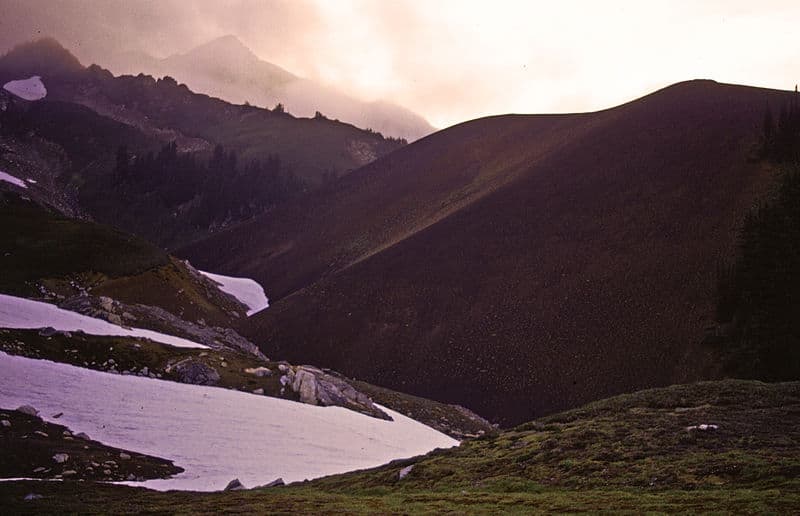
White Chuck Cinder Cone was discovered in 1934 and can only be accessed by hiking.
©Briant Cockrum, CC BY-SA 3.0 – License
The first volcano on the list is White Chuck Cinder Cone which is located near Glacier Peak in Snohomish County. It stands 6,002 feet high and it is estimated that it last erupted somewhere between 17,000 and 2,000 years ago. Incredibly, it was only discovered in 1934. White Chuck Cinder Cone is often regarded as being one of the most remote cinder cones in the Cascade Mountains and can only be accessed by hiking. As a cinder cone volcano, it has an oval-shaped cone with a large bowl-shaped crater.
7. Goat Rocks — 8,184 feet

The peak of Goat Rocks offers a stunning view of the surrounding Cascade mountains.
©Mel Walkup/Shutterstock.com
Goat Rocks is an extinct volcano which is located in southern Washington, between Mount Rainier and Mount Adams. Goat Rocks first erupted during the Pliocene, with the last eruption occurring around 115,000 years ago. Since it became extinct it has undergone much glacial erosion which has worn away many layers of volcanic ash. Its height today is 8,184 feet, but this is significantly smaller than it would have been when it was active. In fact, there are still several large glaciers on the mountain today which continue to shift and strip away the surface. The conditions are harsh on Goat Rocks, but it is still home to a variety of different animals, including a herd of mountain goats, from which it receives its name. There are also several species of deer and elk as well as smaller animals such as marmots.
6. Mount St. Helens — 8,364 feet
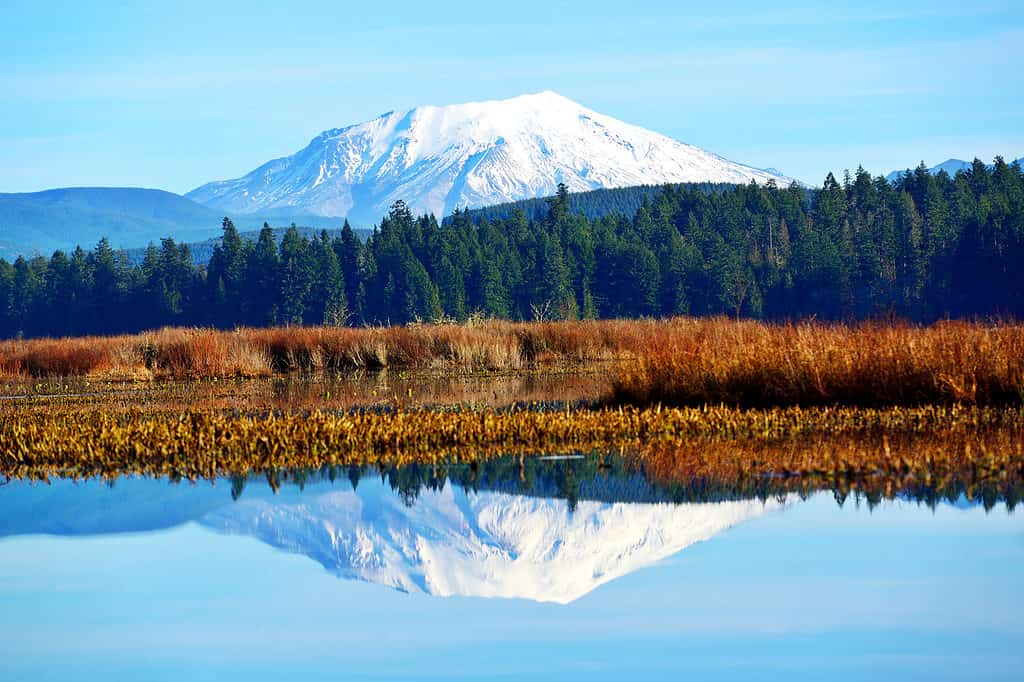
Now standing at 8,364 feet, Mount St. Helens lost 1,000 feet from the summit in the 1980 eruption.
©Nadia Yong/Shutterstock.com
Undoubtedly the best known volcano in Washington is Mount St. Helens which was the source of one of deadliest volcanic eruptions in the US. Mount St. Helens stands 8,364 feet high and is located in Skamania County, in the western region of the Cascades. However, the deadly 1980 eruption took more than 1,000 feet off the height of the mountain. The last eruption occurred in 2008, but scientists predict that future significant eruptions are likely due to the way that the lava domes are currently positioned. Despite the volatile nature of the mountain, life incredibly continues to make a comeback on it. Western toads are a particular success story as, although they are endangered in several states, they managed to make a comeback around Mount St. Helens due to a lack of predators after its eruptions.
5. Black Buttes — 9,373 feet
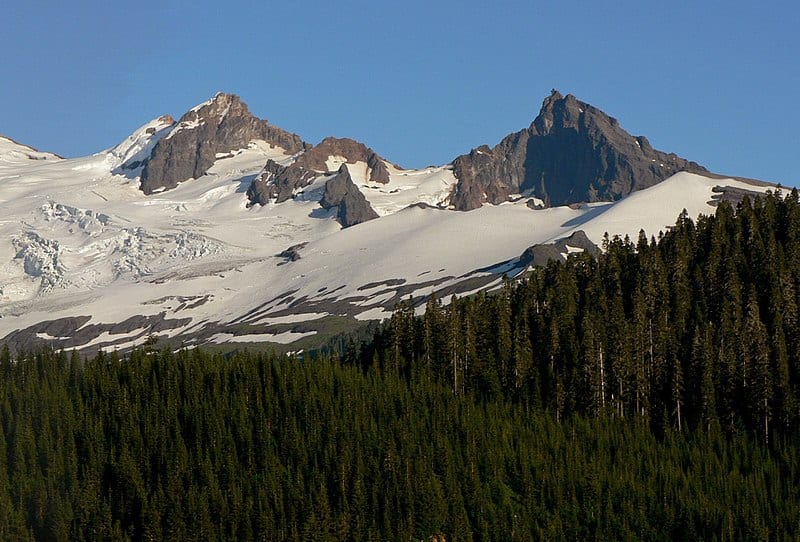
Black Buttes has three major peaks which are all popular with hikers and climbers.
©Walter Siegmund, CC BY-SA 3.0 – License
Also known as Sawtooth Rocks, the Black Buttes are an extinct volcano in Whatcom County. It currently stands at 9,373 feet and last erupted somewhere between 495,000 and 288,000 years ago. Incredibly, its neighbor, Mount Baker, is situated on lava that came from Black Buttes. Black Buttes features numerous rugged peaks, and its three major ones — Colfax, Lincoln, and Seward — are all popular with hikers and climbers. There are plenty of animals that inhabit the area, including bears and mountain lions.
4. Glacier Peak — 10,541 feet
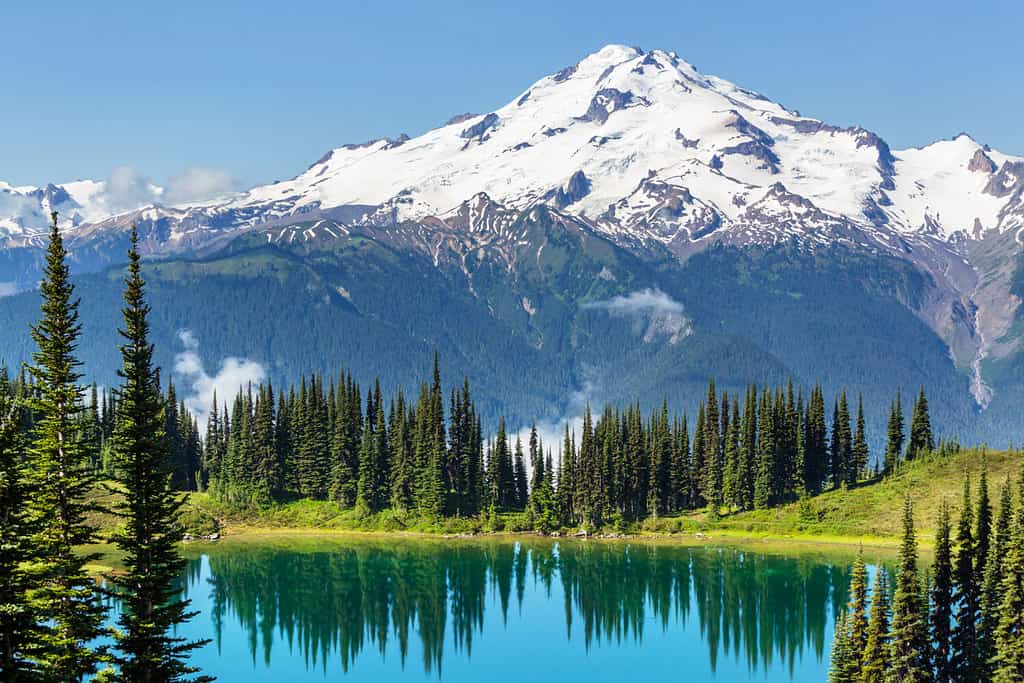
Glacier Peak last erupted in 1700 and evidence of mudflow deposits can be seen running down to the valley below.
©Galyna Andrushko/Shutterstock.com
Also known locally as Dakobed, Glacier Peak is a 10,541-foot-high stratovolcano in the Glacier Peak Wilderness region of the Mount Baker-Snoqualmie National Forest. Along with Mount St. Helens and Mount Baker, Glacier Peak is the only volcano in Washington to have erupted in recent history, with the last eruption occurring around 1700. Evidence of past eruptions are visible as large lava domes that make up part of the summit. There are also several mudflow deposits (lahars) that run down into the surrounding valley. The surrounding forests and its rugged glaciers are teeming with wildlife, with deer, elk, and mountain goats being amongst the most common animals. However, bears, gray wolves, and mountain lions also live in the area.
3. Mount Baker — 10,778 feet
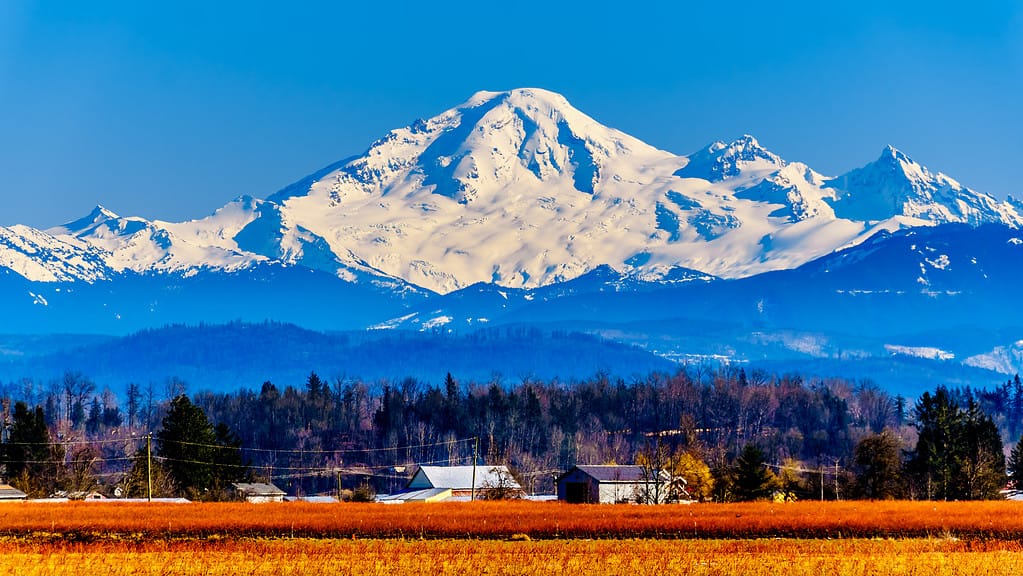
Mount Baker is one of the youngest volcanoes in Washington.
©Harry Beugelink/Shutterstock.com
The third tallest volcano in Washington is Mount Baker which stands at 10,778 feet. It is located in the North Cascades and is one of the youngest volcanoes in the state, with estimations putting it at between 80,000 and 140,000 years old. Although the last eruption of lava occurred approximately 6,000 years ago, it has still produced much thermal activity in recent years, including an eruption of steam in 1975. Mount Baker has two craters at its summit, with the largest — Carmelo Crater — being a massive 1,300 feet wide. Although conditions are harsh on Mount Baker, especially during the winter, it is covered with herbaceous vegetation above the tree line and is home to bears, mountain lions, marmots, mountain goats, and even several species of trout.
2. Mount Adams — 12,281 feet
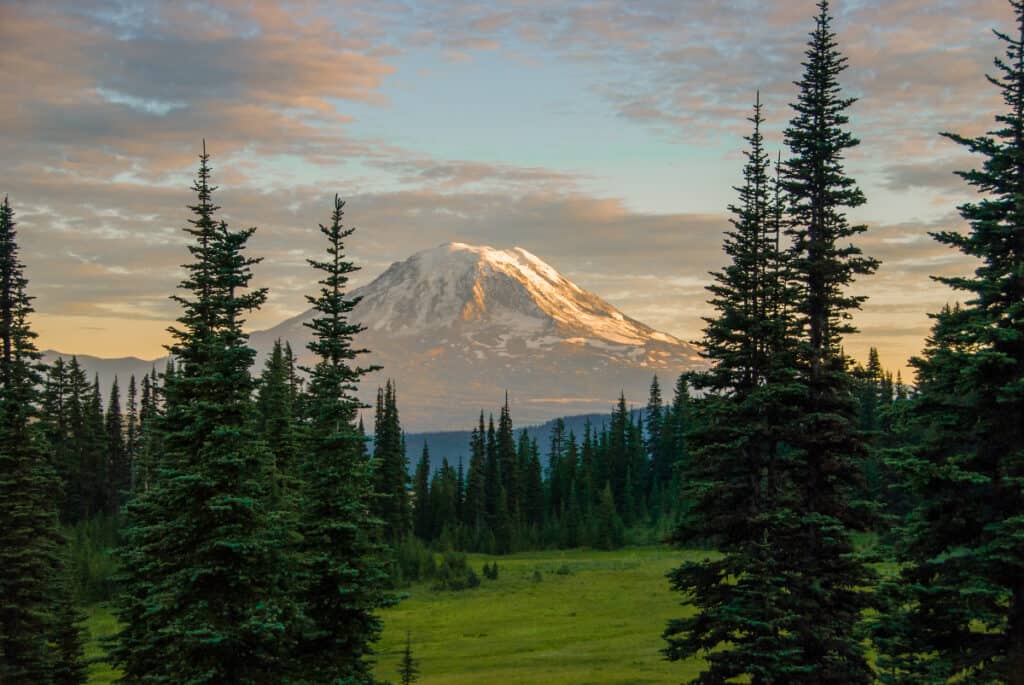
Mount Adams has a broad, flat summit which was formed by past eruptions.
©iStock.com/climbbike
Another remote volcano in the Cascades is Mount Adams which stands 12,281 feet high. The western half of the mountain is located in the Mount Adams Wilderness area, but the eastern half forms part of the Yakama Indian Reservation. Mount Adams has a distinctive appearance with a broad, flat summit which was formed by cone-building eruptions. Although Mount Adams has not erupted for approximately 1,000 years, it is not classed as being extinct as experts believe it could still erupt again in the future.
Despite its remote location, Mount Adams is popular with hikers, climbers, and skiers. It also has a diverse range of both plants and animals. Until 2015, one of the largest ponderosa pines in the world (202 feet high) stood at the base of the mountain. The headwaters of both Lewis River and White Salmon River are located on Mount Adams. These are rich with many species of fish, although trout are particularly common.
1. Mount Rainier — 14,411 feet
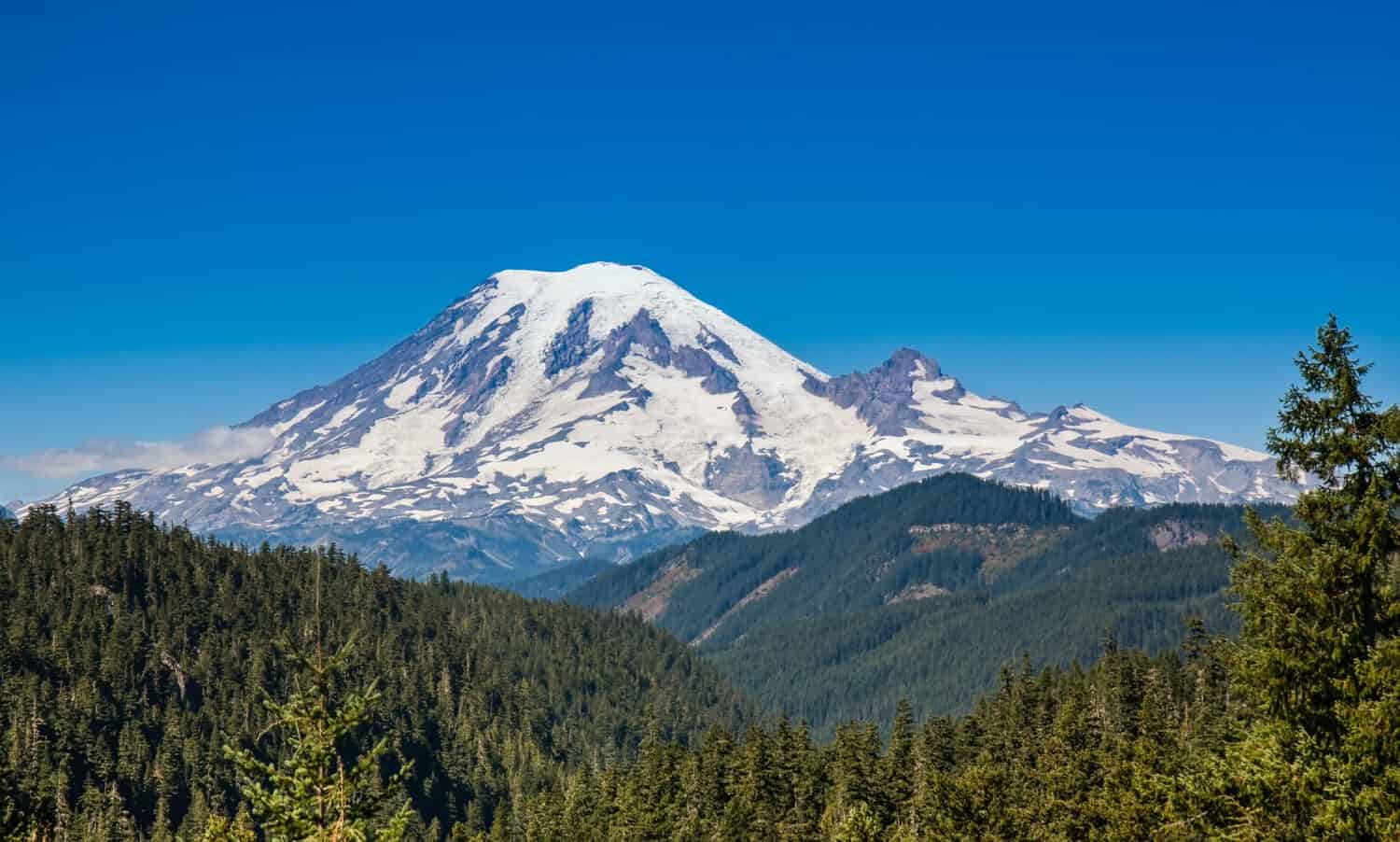
Mount Rainier is one of the most dangerous volcanoes in the world.
©picturin/Shutterstock.com
The tallest volcano in Washington state is Mount Rainier which stands a staggering 14,411 feet high. Also known as Tahoma, Mount Rainier is located in Pierce County, just 40 miles from Tacoma. It is considered to be one of the most dangerous volcanoes in the world due to the high probability of it erupting in the near future. It last erupted in 1894 when several explosions occurred at its summit. Mount Rainier is popular with climbers, although it is a difficult expedition due to the massive glaciers on it that need to be navigated.
There is a vast range of flora and fauna on Mount Rainier, with the mountain considered to be an excellent place to see wildflowers. The old-growth forests on it also consist of several stunning species of cedar, fir, and pine trees. Furthermore, there are several protected and endangered animals on the mountain, including the northern spotted owl which is a subspecies of the spotted owl. Other animals in the region include frogs, mountain goats, mountain lions, foxes, and elk.
Summary of the 8 Tallest Volcanoes in Washington State
| Rank | Volcano | Height |
|---|---|---|
| 1 | Mount Rainier | 14,411 feet |
| 2 | Mount Adams | 12,281 feet |
| 3 | Mount Baker | 10,778 feet |
| 4 | Glacier Peak | 10,541 feet |
| 5 | Black Buttes | 9,373 feet |
| 6 | Mount St. Helens | 8,364 feet |
| 7 | Goat Rocks | 8,184 feet |
| 8 | White Chuck Cinder Cone | 6,002 feet |
The photo featured at the top of this post is © Bill Perry/Shutterstock.com
Thank you for reading! Have some feedback for us? Contact the AZ Animals editorial team.






